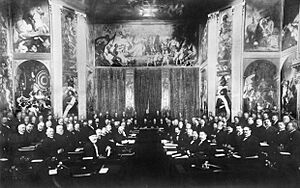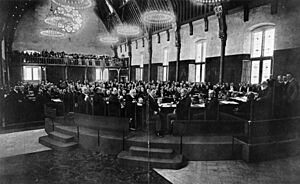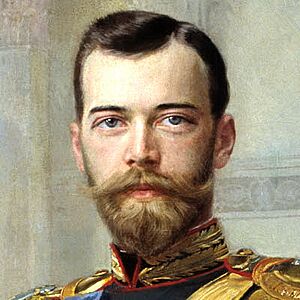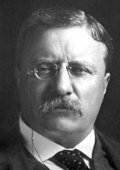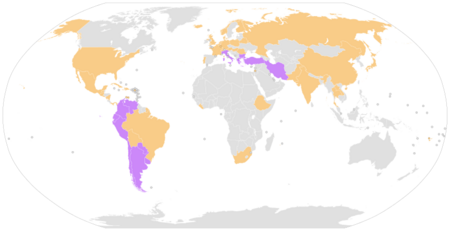Hague Conventions of 1899 and 1907 facts for kids
The Hague Conventions of 1899 and 1907 are a set of important international agreements. They were created at two large peace conferences. These meetings took place in The Hague, a city in the Netherlands. Along with the Geneva Conventions, the Hague Conventions were among the first official rules. They set down how wars should be fought. They also defined what counts as a war crime under international law. A third conference was planned for 1914 but was canceled. This was because World War I began.
Contents
Making Rules for War: A Look Back
The Hague Conventions were the first major international agreements. They focused on how countries should behave during wartime. A big part of these rules came from the Lieber Code. This code was created by US President Abraham Lincoln. He issued it in 1863 during the American Civil War.
The Lieber Code was the first detailed set of rules for war. It covered many topics. These included how to treat civilians and their property. It also set rules for prisoners of war and deserters. The code talked about truces and respecting human life. It was seen as a great guide for wartime behavior. Many other countries later used it as a model.
The 1874 Brussels Declaration also took ideas from the Lieber Code. While not fully adopted, it showed the growing need for clear war rules. Much of what ended up in the Hague Conventions was inspired by the Lieber Code. The Korean Empire attended the 1899 conference. They were an independent country at that time.
Why These Conferences Were Held
Both conferences aimed to discuss important topics. These included disarmament, which means reducing weapons. They also focused on the laws of war and war crimes. A main goal was to create a strong international court. This court would help settle disagreements between countries. The idea was to prevent wars by having a peaceful way to solve problems.
This goal was not fully met at either conference. Instead, they set up a voluntary court. It was called the Permanent Court of Arbitration. Many countries, like the United States, Great Britain, and Russia, wanted a court with binding decisions. But a few countries, especially Germany, said no.
The Hague Convention of 1899
The First Hague Conference started because of a suggestion. Russian Tsar Nicholas II proposed it in August 1898. The conference officially began on May 18, 1899. The agreements were signed on July 29 of that year. They became official on September 4, 1900. The 1899 Hague Convention included three main agreements and three extra declarations:
- Convention (I): Peaceful Settlement of International Disputes
- This agreement created the Permanent Court of Arbitration. This court still exists today. It was approved by many countries. It helps nations solve problems peacefully.
- Convention (II): Laws and Customs of War on Land
- This long agreement set rules for wars fought on land. It covered how to treat prisoners of war. It also included rules from the First Geneva Convention for treating wounded soldiers. It banned using poisons and killing soldiers who had surrendered. It also made looting towns and attacking undefended places illegal. People in occupied territories could not be forced to fight against their own country. Collective punishment was also forbidden.
- Convention (III): Adaptation of the Principles of the Geneva Convention to Maritime Warfare
- This agreement protected marked hospital ships. It required them to help wounded and shipwrecked sailors from all sides. All major countries approved this.
- Declaration (IV,1): Launching Projectiles and Explosives from Balloons
- This declaration said that for five years, no bombs or explosives could be dropped from balloons. This also applied to "other new methods of a similar nature."
- Declaration (IV,2): Use of Asphyxiating Gases
- This declaration stated that countries would not use projectiles. These were "the sole object of which is the diffusion of asphyxiating or deleterious gases." This meant no poison gas.
- Declaration (IV,3): Use of Expanding Bullets
- This declaration banned "bullets which expand or flatten easily in the human body." This stopped the use of bullets like soft-point or "dum-dum" bullets.
The Hague Convention of 1907
The Second Hague Conference in 1907 didn't make many new big changes. But it was important because major world powers met. This meeting showed early attempts at international teamwork.
U.S. President Theodore Roosevelt suggested this second conference in 1904. It was delayed because of the Russo-Japanese War. The conference took place from June 15 to October 18, 1907. Its goal was to build on the 1899 convention. It aimed to update some parts and add new topics. The 1907 conference especially focused on naval warfare.
Britain tried to limit the number of weapons countries could have. But other powers, led by Germany, stopped these efforts. Germany feared Britain wanted to stop the growth of the German fleet. Britain had the world's largest navy. So, limits on naval growth would keep them in charge. Germany also rejected ideas for mandatory arbitration. However, the conference did improve ways for voluntary arbitration. It also set rules for collecting debts and the rights of neutral countries during war.
The agreements from the Second Conference were signed on October 18, 1907. They became official on January 26, 1910. The 1907 Convention has thirteen agreements. Twelve of them were approved and became law. It also included one declaration:
- Convention (I): Pacific Settlement of International Disputes
- This agreement confirmed and expanded on the 1899 Convention (I). It is still active for many countries today.
- Convention (III): Opening of Hostilities
- This agreement set out the accepted way for a country to declare war. It also provided a basis for demanding war reparations (payments for war damage).
- Convention (IV): Laws and Customs of War on Land
- This agreement confirmed the rules from the 1899 Convention (II). It had only small changes. All major powers approved it.
- Convention (X): Adaptation of the Principles of the Geneva Convention to Maritime Warfare
- This agreement updated the 1899 Convention (III). It reflected changes made to the 1864 Geneva Convention. Most major countries approved it. It was later replaced by the Second Geneva Convention.
- Convention (XII): Creation of an International Prize Court
- This agreement would have created an International Prize Court. This court would have settled arguments about captured ships during wartime. This is the only agreement that never became law. Only Nicaragua approved it.
- Declaration (XIV): Prohibiting the Discharge of Projectiles and Explosives from Balloons
- This declaration extended the ban from 1899 on dropping bombs from balloons. It was meant to last until a third peace conference. That conference never happened.
Key People at the Conferences
Many important people attended these conferences. The Brazilian team was led by Ruy Barbosa. He helped defend the idea that all nations should be treated equally under the law. The British team included Sir Edward Fry and Sir Ernest Satow. The Russian team was led by Friedrich Martens. José Batlle y Ordóñez led the Uruguayan team. He supported the idea of mandatory arbitration.
Paul Henri d'Estournelles de Constant was part of the French team for both conferences. He later won the Nobel Peace Prize in 1909 for his efforts. The U.S. representative was U. M. Rose. China's main representative was Lu Zhengxiang. He later became Prime Minister of China.
The Geneva Protocol: An Important Addition
Even though it wasn't negotiated in The Hague, the Geneva Protocol is seen as an addition to the Hague Conventions. It was signed in 1925 and became law in 1928. Its single rule permanently bans the use of all chemical and biological warfare in wars between countries. This protocol came about after the terrible use of mustard gas in World War I. People feared what chemical and biological weapons could do in future wars. Later, the Biological Weapons Convention (1972) and the Chemical Weapons Convention (1993) added more rules.
What the Conventions Left Behind
Many rules set at the Hague Conventions were broken in World War I. For example, Germany invaded neutral Luxembourg and Belgium in 1914. This went against Convention (V) of 1907. That rule said countries at war must not enter neutral territory. Also, Poison gas was used by all major countries during the war. This broke the 1899 Declaration (IV, 2) and 1907 Convention (IV). These rules clearly forbade using "poison or poisoned weapons."
After World War II, judges at the Nuremberg Trials made an important decision. They said that by 1939, the rules in the 1907 Hague Convention IV were recognized by all civilized nations. This meant they were considered the standard laws of war. So, a country didn't have to have officially approved the 1907 Hague Convention to be bound by its rules.
Even though newer agreements have replaced some of their content, the Hague Conventions of 1899 and 1907 are still important. They show the lasting need for rules in war. They also remind us how important it is to try and avoid war completely. Since 2000, many more countries have approved Convention (I) of 1907. This shows a continued interest in peacefully settling international disagreements.
See also
- List of parties to the Hague Conventions of 1899 and 1907
- American Peace Society
- Antimilitarism
- Command responsibility
- Hague Secret Emissary Affair
- Martens Clause
- Militarism
- Rule of Law in Armed Conflicts Project
- Saint Petersburg Declaration of 1868
- World Federation


